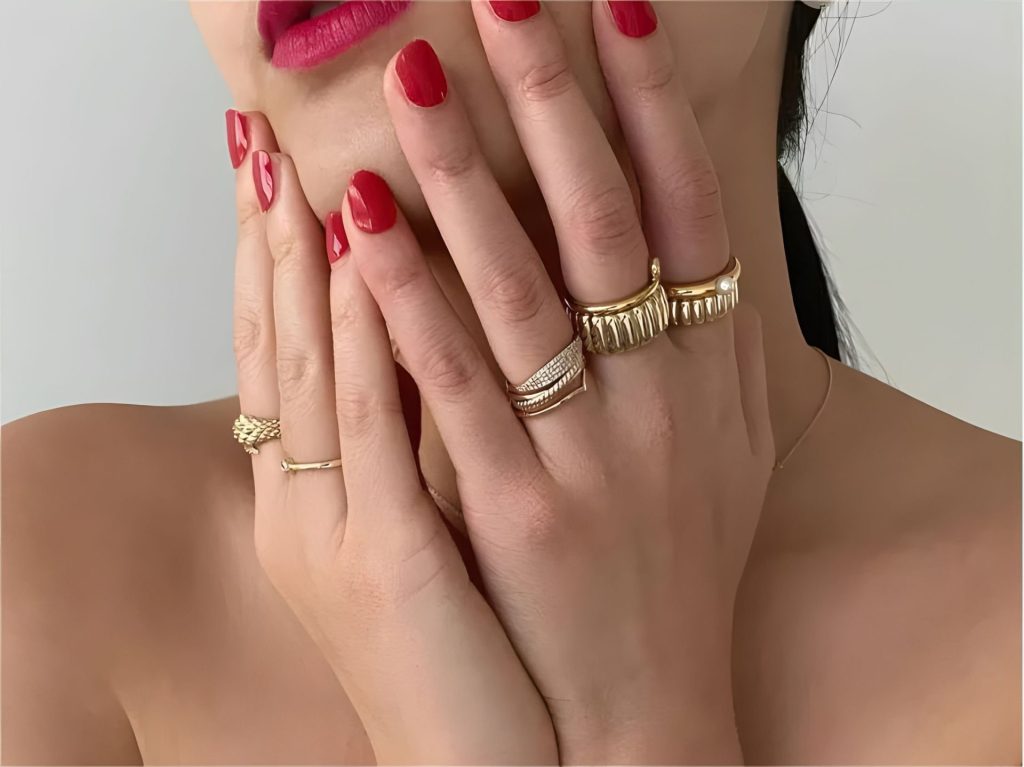What glitters, isn’t entirely gold. A thin layer of gold is wrapped around a base material such as copper or brass to create gold-plated jewelry. When the gold coating starts to fade and exposes the metal beneath, it can cause tarnishment. It can be frustrating to see your jewelry discolor, but this is not inevitable. We’ve collected four simple tips and tricks for you from professionals. Jewelry designers and experts have some solid-gold tips to help you keep the tarnish away.
What is gold-plated jewelry?
Gold-plated jewelry is jewelry made of a base metal such as brass or copper, with a thin gold layer. The gold is applied to the metal through a process known as electroplating.
Fortune & Frame’s founder Gretel Goin says that not all gold-plated jewellery is the same. There are two ways to plate jewelry. The coating can be as thin as a spray of paint or extremely thick. This makes it less likely for the gold to fade.
Why does gold-plated jewelry tarnish?
Let’s first discuss why tarnishing occurs. The main reason for tarnishing is that the gold plating on items is thin and is placed over a base metal. This makes them stronger and less likely bend. Over time, however, the base metal eventually reaches the surface and discolors the gold. The gold is broken down by this process and must be maintained and polished to bring back its shine. There are ways to keep gold-plated jewelry looking luxurious by preventing it from tarnishing.
Regularly Clean Your Jewelry
Marisa HORDERN, the founder of jewelry brand Missoma, says that jewelry can be cleaned using a “soft non-abrasive chamois or cloth to keep it shining.” The brand recommends that you clean your jewelry at least once per year and more often if it is a favorite piece.
Begin by gently rubbing or spot treating the gold-plated jewelry. Amber Glassman is the CEO and co-founder of Bryan Anthonys. She echoes the tip to use a lint free cloth: “Do NOT use a polishing fabric, as it will strip off any plating.”
Sally Rong, founder of Rellery, says that cleaning and wiping your jewelry regularly after wearing can keep it gleaming and free from scratches for a longer time. Suhani Parekh, founder and creative director of Misho, suggests that wearing your jewelry regularly can be part of the maintenance process if you have sterling silver with a gold plating. She says that the oils in your skin can help to prevent tarnish from building up on silver.
Sophie Monet Okulick of Sophie Monet suggests that if you want to deep clean your pieces, “mix warm water with dish soap in a small container, soak them for a few moments, then rinse and wipe them clean.” Avoid using antibacterial soaps, which can tarnish the gold plating. You can also take it to a professional for re-plating or cleaning if this doesn’t work.
Avoid contact with water
Gold-plated jewelry should be removed when you are swimming or showering to avoid premature damage. Hordern told Byrdie that “Chlorine and salt water can damage precious metallics by dulling them or eroding.” The soapy water used in baths and showers can leave a thin layer on the metal, making it appear dull.
Be Careful With Perfume
Going warns people who wear gold-plated jewelry to refrain from spraying perfume directly on the pieces. The Fortune & Frame designer explains that depending on the perfume the chemicals may cause a similar reaction to oxidation. This can make your gold black. The process is reversible but it can be shocking if not expected.
How to Store Gold-Plated Jewelry
Knowing how to clean gold-plated jewelry is as important as understanding how to store your favorite necklaces and earrings. To prevent fading and tarnishing, all of our experts suggested storing jewelry in a case, pouch or jewelry box. Hordern told Byrdie that if you want to give your jewelry the best care, keep it in a cool, dark place. Avoid humidity or heat to prevent tarnishing.
Acosta says that storing jewelry in dark or a pouch will also prevent it from being exposed to humidity, which could alter the plating. Glassman advises that you should keep your jewelry pieces separated from each other to prevent them coming into contact with anything that could scratch or chip their finish.
When gold-plated jewelry comes into contact with chemicals or external elements, certain base metals can discolor it. Going tells Byrdie that brass, for example, is a highly reactive metal. When exposed to high humidity levels or saltwater, it can react and begin breaking through the plating.
Gold-plated jewelry should be the last item you wear and the first thing that you remove. This will protect the jewelry from being exposed to too many soaps, lotions and perfumes that can cause tarnish.
How long should gold-plated jewelry last?
Rong says that with the right care, gold-plated jewelry can last up to five-years. Going says that it’s important to keep the jewelry away from chemicals, such as perfumes and cleaners, and from elements like salt, water, sweat and high humidity. If it begins to fade, learn how to restore it by repairing tarnishing.

